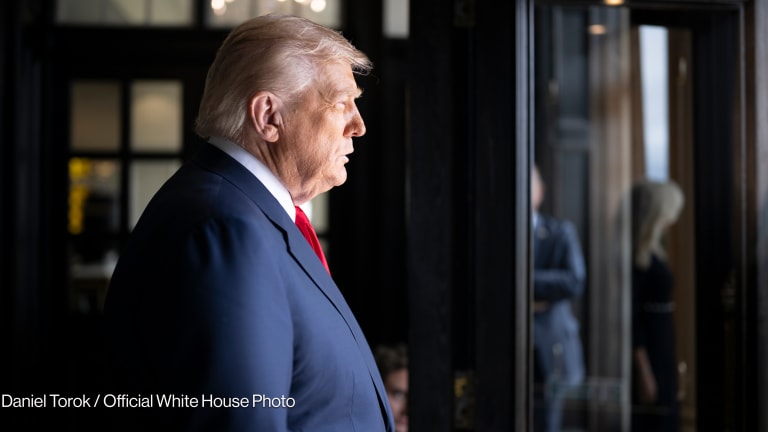
WASHINGTON — When details about the Trump administration’s first budget request began to leak out in early 2017, they incited a general panic among the United States global development community.
Some media outlets predicted “the end of foreign aid as we know it,” development experts called the budget blueprint that eventually emerged a “dangerous document,” while Democratic lawmakers derided it as “immoral.” The White House wanted massive cuts to foreign assistance accounts, calling for a more than $10 billion reduction that amounted to nearly 30 percent of the overall U.S. aid budget.
“There's no question this is a hard power budget … that was done intentionally,” said Mick Mulvaney, the long-time foreign aid skeptic and fiscal hawk who directs the White House Office of Management and Budget, as he unveiled the plan. The worst fears about what “America First” might mean for U.S. aid seemed to be coming true.
See more on the U.S. aid budget:
► What the budget bill says about the future of US aid
► Congressional appropriators push back on US foreign aid cuts in two hearings
► Set of congressional budget hearings lay out US aid funding
In the 15 months — and two budget cycles — that have since passed, the Trump administration and the U.S. Congress have settled into a predictable standoff over U.S. aid spending, the budget appropriations equivalent of the daily, choreographed military ceremony at the India-Pakistan border. The Trump administration displays a dramatic assault on U.S. soft power, the lawmakers who oppose it accuse the White House of endangering the country, and ultimately, Congress approves a spending plan that looks more or less like the one that came before it.
An open question has been whether President Trump’s White House — and its political base — would find enough satisfaction in demonstrating a desire to slash U.S. foreign aid spending, without seeing that desire translated into real budgetary policy.
Rumors began to circulate in recent weeks about a new plan, hatched by Mulvaney, to escalate the administration’s war on foreign aid and circumvent a budget appropriations process that vests Congress with much more power than the White House. Sources with knowledge of the budget process told Devex that OMB had informed the U.S. Agency for International Development that it was considering rescinding any remaining funding from fiscal year 2017 that had not been obligated by mid-August.
In response to an inquiry from Devex about whether the White House had communicated with USAID about such a plan, an OMB official wrote, “OMB would not and cannot direct agencies to stop spending funds.” The official did not respond to additional requests to clarify whether that meant that OMB would also not seek to reclaim any unspent funds.
On Thursday, at a Senate Committee on Foreign Relations confirmation hearing for David Hale, nominee to be the under secretary of state for political affairs, Senators Robert Corker and Robert Menendez publicly acknowledged their concern about the rumored “rescissions package” that will allegedly target U.S. foreign aid. Menendez threatened to block the administration’s nominees if they go forward with the effort to return congressionally appropriated funding.
Asked why the White House would risk souring its relationship with members of Congress over a relatively small amount of money, one development advocate responded simply with a GIF of a woman dancing to Meghan Trainor’s lyrics “All About that Bass” — the implication being that this administration is “all about” its political base.
The fact that USAID is still holding onto funding obligated for the 2017 fiscal year might sound like mismanagement, but the funding OMB is targeting is money obligated for two years, ending with the current fiscal year on Sept. 30. The 2017 budget was also not finalized until May, more than seven months after the fiscal year had already begun.
In recent weeks, USAID’s leaders have sought to speed up their spending, according to multiple people with visibility into the contracting process. One development consultant who shared insights on the condition of anonymity described a “mad dash” to obligate funds and believed this to be driven at least in part by the looming threat of an OMB rescission package. The recent spending uptick also follows a more banal pattern that plays out every year of seeing funding obligations accelerate as the fiscal year draws to a close.
This year, USAID Administrator Mark Green has also sought to bring the agency in line with its spending benchmarks, according to a USAID official who shared information on background. USAID internal guidelines, published every fiscal year, set targets for the agency’s funding obligation rates. The guidance for fiscal year 2018 was for 85 percent of the agency’s funding to be obligated by July 31. Recognizing that USAID was not meeting that target, the agency’s leadership pushed for accelerated spending in late July and early August, according to the official.
Now that lawmakers have vowed to push back against any White House effort to rescind the funding they have already allocated for global development programs, the race is on to figure out what tools Congress has at its disposal to do that — and to put those tools to use before it is too late.
Whether or not the White House is successful in this effort to circumvent the standard budget process and return U.S. aid funding to its sender, Mulvaney and his allies have made one thing clear. This administration is not content with simply proposing to cut foreign assistance.








